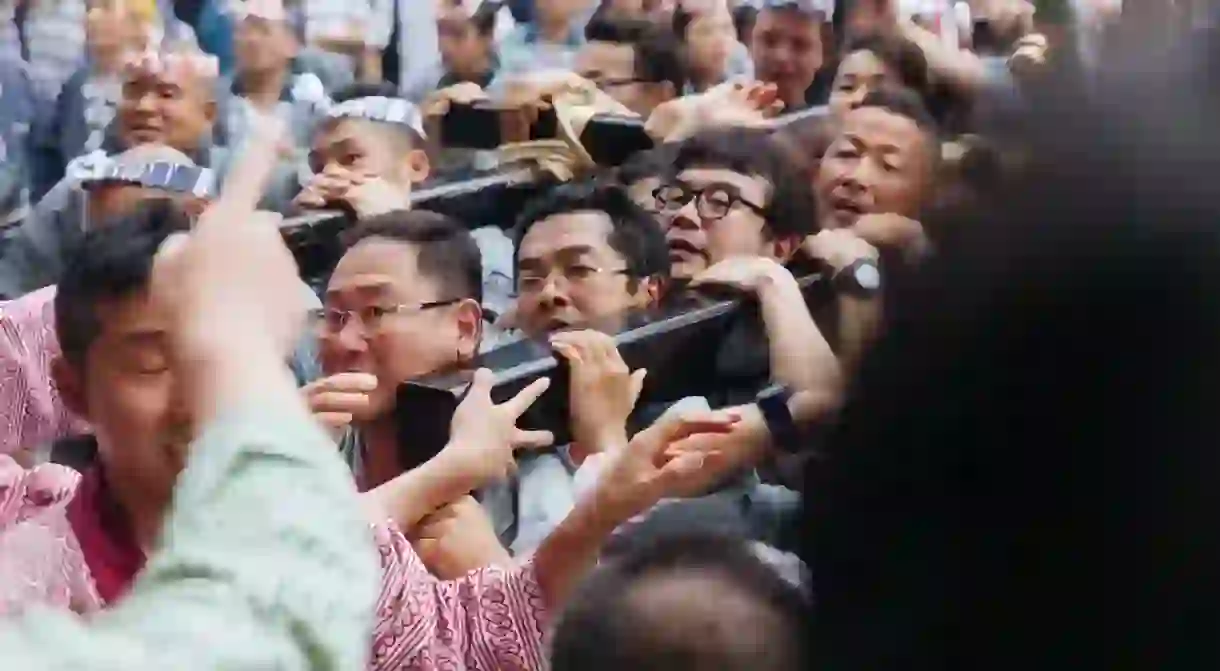How to Celebrate Sanja Matsuri

It’s one of the biggest celebrations in Tokyo and a must-see for anyone passing through the city in mid-May. Here’s everything you need to know about making the most of Sanja Matsuri.
When it takes place
The festival is a three-day celebration traditionally held during the third weekend in May. This year’s event began on May 18, and next year’s shindig will commence on May 17.


How to get there
Senso-ji Temple is the epicentre of the festival and its main focal point. The site is only a five-minute walk from Asakusa Station, which is on the Ginza Line and Asakusa Line on Tokyo’s Metro as well as the Tobu Railway Line.



What to do when you get there
Festivities are spread throughout the day, so there’s no need to rush. The party gets started with the Daigyoretsu Parade on Friday, where a contingent of priests, city officials, geisha, musicians and dancers make their way along Yanaga Dori to the main shrine at Senso-ji. Afterwards, a Shinto ceremony is held and the first of the portable shrines named mikoshi are carried throughout the streets. Expect to have your eardrums tickled by the many musicians playing traditional instruments, most notably the fearsome Taiko drums.


On the Saturday, about a hundred smaller mikoshi are carried through the streets surrounding the temple, borne aloft by everyone from adults to women and children. The idea is that the mini-shrines spread peace and prosperity, so everyone does their best to try and get close to the shrines. The main event comes on Sunday, the grand climax of the festival. Following a 6am start, three large groups carry the main mikoshi through the streets in a display of strength, speed and above all, shouting. They compete with each other for shrine superiority, before the shrines are then paraded through the local neighbourhood to bestow blessings on residents, businesses and visitors. After that, they are carried back to Senso-ji for the festival’s close, but revellers remain in the area well into the night.



What to eat
If you love street food, then Sanja Matsuri is a haven of sweet and savoury delights. Vendors sell a huge array of mouth-watering morsels, so much so that you’ll be spoilt for choice. Yakisoba – Japanese fried noodles – are always a popular festival repast, as are chocolate-covered bananas. As one of the most hygienic nations in Asia, Japan has decent food safety, and most of its street food is reliable and safe to eat. And you won’t have a problem finding anything to drink – soft drinks and alcohol, especially beer, are always on hand. Littering is considered anathema in Japan, so take any and all rubbish home with you (street bins are all-but-impossible to find).


How to celebrate it like a local
Sanja Matsuri is an energetic event attended by millions of people. Needless to say, it’s not the sort of place to go if you don’t fancy big crowds and lots of noise. If you do, you’re in luck, as the festival is a massive party where all ages are welcome. Visitors often attend in traditional Japanese garb, though rocking up in civvies is also fine.


Try the street food, buy a beer and enjoy the convivial atmosphere, but be aware that there are a few very important factors to be aware of. Firstly, the good-natured rowdiness can take foreigners by surprise, and Japanese people carrying mikoshi will often – and loudly – clear the streets so they can have easy passage. Do not stand in their path. If you get in the way, you’ll be bluntly ordered to move.



Also, climbing on top of the mikoshi is a massive no-no. These things are huge and weigh a ton, so any attempt at a ‘wacky’ (read: stupid) photo opportunity will put a number of people in danger. No matter what you may see locals do (attending Yakuza sometimes try their luck), don’t attempt to copy them under any circumstances.
With up to two million people attending every year, the area can get extremely busy – proceed with extreme caution if you experience claustrophobia, and be aware that mid-May is when temperatures in Tokyo start to rise. Keep a bottle of water handy at all times, and make sure you’re wearing sensible clothing. Bulky backpacks or luggage should be left at home.


As mentioned above, don’t be surprised or alarmed if you spot men (and sometimes women) with Yakuza-style tattoos. They are a regular sight at the annual event. As an event positively awash with booze, noisy drunken arguments are not unheard of. Use common sense and be smart if you witness people having a heated exchange after several Asahis.
















